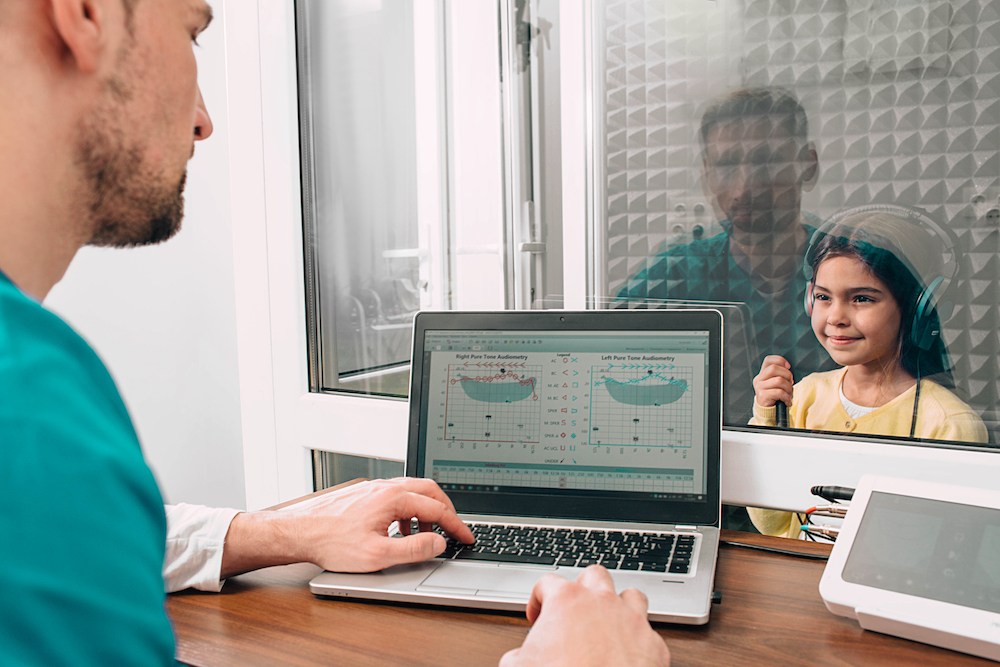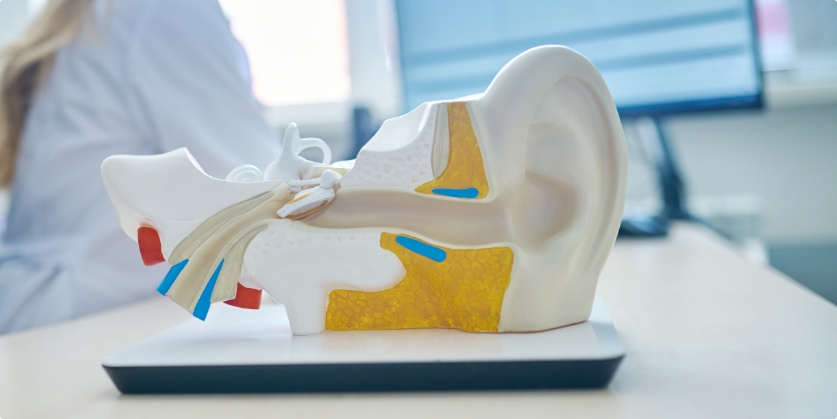Hearing Loss and Aging: What Everyone Over 50 Should Know
As we age, we will experience various changes in our physical health and
Our Elizabethtown Office has MOVED to 939 East Main St. Mount Joy, PA! Learn More →

By: admin | September 25, 2024
As technology evolves, so do the techniques used by professionals to address hearing loss. An interesting intersection between virtual reality (VR) and hearing loss has appeared, offering a fresh perspective that may seem like something out of a science fiction novel. But this forward-thinking method is swiftly becoming a reality in the field of hearing health. The potential uses of this technology could transform how you handle your hearing loss and enrich your daily life experiences. Just as every person’s experience with hearing loss is unique, so too are the possible solutions – with virtual reality emerging as an encouraging tool for use with hearing loss.
Virtual reality is an immersive technology that creates a simulated environment, allowing users to experience and interact with a three-dimensional world that feels real. This technology uses a combination of hardware and software to provide a highly engaging and interactive experience.
The core of VR technology is a headset, which contains lenses that project images directly in front of the user’s eyes. These lenses create a stereoscopic effect, making the digital environment appear three-dimensional. The headset also includes sensors and motion tracking technology, which track the user’s head movements and adjust the images accordingly, ensuring that the environment responds naturally to the user’s actions.
In addition to the headset, VR systems often include controllers or gloves equipped with sensors. These devices allow users to interact with the virtual environment by moving their hands, manipulating objects or performing specific actions. The system’s software generates the virtual world, including its visuals, sounds and interactive elements, providing a comprehensive sensory experience.
Overall, VR technology combines visual, auditory and sometimes haptic (touch) feedback to create a believable and interactive digital experience. This technology is used in various fields, including gaming, training simulations, education and even therapy, offering users a unique way to engage with digital content.
Virtual reality is making significant strides in the medical field, offering innovative solutions for diagnosis, treatment and patient care. This technology provides a range of applications that enhance medical training, improve surgical precision, support mental health therapy and facilitate patient rehabilitation.
Recognizing the signs of hearing loss is crucial for addressing it early and improving your overall well-being. Hearing loss can manifest in various ways, and its onset is often gradual, making it easy to overlook. Common signs include frequently asking others to repeat themselves, especially in group settings or noisy environments. This struggle can also extend to difficulty following conversations on the phone or during social gatherings. You might notice that people around you seem to speak too softly or mumble, which can be frustrating and isolating. Additionally, if you find yourself constantly increasing the volume on your television, radio or other audio devices to levels that others find uncomfortable, it could be an indication of hearing difficulties.
In some cases, hearing loss may also be accompanied by tinnitus, a condition characterized by ringing or buzzing sounds in the ears. If you experience these symptoms, it’s important to schedule a hearing evaluation with an audiologist. Early detection through regular hearing assessments can help identify hearing loss before it becomes more severe.
Diagnosing hearing loss typically involves a comprehensive evaluation conducted by an audiologist. The process starts with a thorough review of your medical history, including any past ear infections, exposure to loud noises or hereditary conditions that might impact your hearing. This history helps the audiologist understand potential underlying causes of your hearing difficulties.
The core of the diagnosis involves a series of tests designed to assess various aspects of your auditory function. An audiometric test is commonly used, which measures how well you hear different frequencies and volumes. During this test, you’ll listen to a series of tones through headphones and indicate when you hear them. The results are plotted on an audiogram, a graph that visualizes your hearing thresholds across different pitches.
In addition to audiometric testing, other evaluations might include speech tests, which assess your ability to understand spoken words at different volumes. Tympanometry may also be performed to evaluate the function of the middle ear by measuring the movement of the eardrum in response to changes in air pressure. For cases where a specific cause of hearing loss is suspected, such as an ear infection or wax buildup, a physical examination of the ear canal and eardrum might be conducted.
One way VR is utilized is by creating simulated environments where users experience realistic sounds and situations. For instance, a VR system can simulate a bustling restaurant or a busy street, allowing individuals to interact with these environments while their hearing responses are monitored. This setup helps audiologists assess how well a person can process and interpret sounds in complex, everyday settings. It can reveal difficulties that might not be apparent in a traditional sound booth, where the focus is often on isolated tones rather than integrated auditory experiences.
Additionally, VR can assist in identifying hearing loss by evaluating spatial hearing and the ability to locate sounds. In a virtual environment, users can be asked to identify the direction of a sound source or follow conversations in a crowded space. These tasks can provide insights into how hearing loss affects spatial awareness and auditory scene analysis.
The immersive nature of VR also offers potential benefits for rehabilitation. By using VR simulations, individuals can engage in auditory training exercises tailored to their specific needs, helping them adapt to their hearing loss in a controlled and supportive environment.
Hearing loss is often treated with hearing aids, which are sophisticated electronic devices designed to amplify sound and improve auditory perception. These devices are tailored to meet individual hearing needs, allowing users to experience clearer and more natural sounds in various environments.
Hearing aids work by capturing sound through a built-in microphone, processing it with advanced digital technology and then delivering the amplified sound to the ear through a speaker. Modern hearing aids are equipped with various features to enhance their effectiveness. These features can include noise reduction to minimize background sounds, directional microphones to focus on specific sound sources and connectivity options for streaming audio from phones or other devices.
Based on the results of your hearing test, the audiologist will recommend a hearing aid model that suits the individual’s hearing profile and lifestyle. Hearing aids come in different styles, including behind the ear, in the ear and canal-worn, each offering various levels of visibility and comfort.
Once a hearing aid is selected, it is custom-fitted to ensure comfort and optimal performance. This fitting process includes adjusting the device to match the user’s hearing needs and ensuring that it fits properly in the ear. Regular follow-up appointments are essential for fine-tuning the settings and making any necessary adjustments to improve the device’s performance.
Hearing aids also require ongoing maintenance to ensure their longevity and effectiveness. This includes routine cleaning, battery replacement and periodic check-ups with an audiologist to address any issues or make adjustments as needed. With proper care and regular adjustments, hearing aids can significantly enhance communication abilities and overall quality of life for individuals with hearing loss.
One of the key ways VR is being used is in auditory training and rehabilitation. VR environments can create immersive scenarios where individuals with hearing loss practice recognizing and interpreting sounds in various settings. These virtual environments simulate real-world situations, allowing users to train their auditory processing skills in a controlled and interactive manner. This can be particularly beneficial for those who have recently received hearing aids or cochlear implants, as it helps them adjust to new auditory experiences and improve their sound discrimination abilities.
Additionally, VR can assist in the assessment of hearing capabilities by offering interactive and engaging tests that measure a person’s auditory perception in different conditions. For instance, VR can simulate noisy environments or complex acoustic scenes, providing a more comprehensive evaluation of hearing function compared to traditional testing methods. This detailed assessment can help audiologists tailor treatments and hearing aid settings more effectively.
VR technology is being explored for its potential in addressing tinnitus, a condition often associated with hearing loss. Virtual environments can be designed to deliver sound therapy and relaxation exercises that may help alleviate the perception of tinnitus. By immersing individuals in calming and distracting virtual worlds, VR can provide a therapeutic experience that complements other tinnitus management strategies.
Just like any other technology, there are certain precautions you should take to ensure a positive and secure experience. This includes avoiding prolonged use, taking regular breaks and setting up a safe space to use your VR equipment.
One challenge you might face is experiencing dizziness or disorientation while using VR. A good solution for this is to start slow with your virtual reality sessions, gradually increasing the duration as you become more comfortable. Always remember that if at any point you feel uncomfortable or unwell during a session, it’s best to stop and take a break. Safety should always be your top priority when incorporating virtual reality into your hearing health routine.
With its ability to simulate real-world scenarios and provide instant feedback, virtual reality could potentially reshape your daily experiences and enhance your quality of life. Every person’s experience with hearing loss is unique, so it’s important to consult with an audiologist who can guide you through the process. At Jul Hearing Aid Solutions in Elizabethtown, PA, our team is ready to educate you on your options. Contact us today at (717) 207-9600 for more information or schedule an appointment!

As we age, we will experience various changes in our physical health and
By: admin | December 28, 2023

Technology is advancing at such a fast rate that we’re seeing its
By: admin | November 25, 2023

Julie Nelson—the owner, operator, and hearing instrument specialist at
By: tinashyverplank | September 21, 2021
